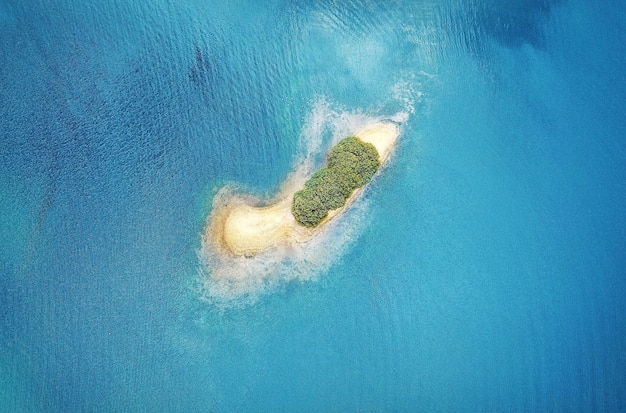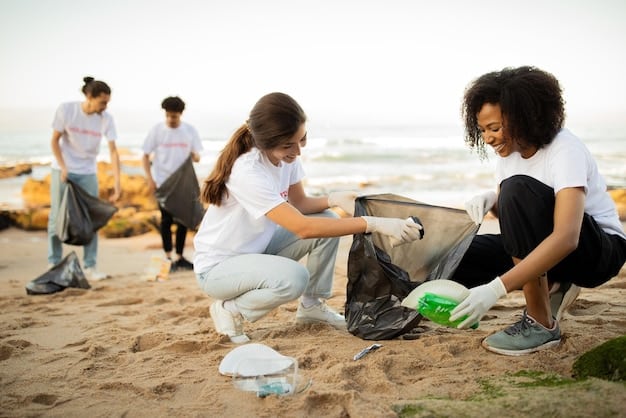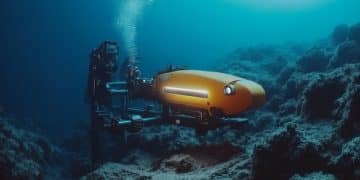Marine Plastic Pollution: 6-Month Progress Report on New Initiatives

This report details the significant progress and challenges encountered over the past six months in implementing new initiatives designed to combat marine plastic pollution, highlighting key shifts in global and local environmental efforts.
The relentless flow of plastic into our oceans poses one of the most formidable environmental challenges of our time, threatening marine ecosystems, human health, and economies. Recognizing the urgency, a surge of innovative strategies and collaborative efforts has emerged. This report, “New Initiatives to Combat Marine Plastic Pollution: A 6-Month Progress Report,” delves into the initial impact and trajectory of these critical interventions, offering a snapshot of successes, hurdles, and the evolving landscape of marine conservation.
The Global Landscape of Plastic Pollution: A Persistent Threat
The sheer volume of plastic entering our oceans annually is staggering, estimated to be between 4.8 and 12.7 million metric tons. This influx doesn’t just create visible debris; it breaks down into microplastics that infiltrate every level of the marine food web, from plankton to whales, and eventually, our own food chain. The economic toll is equally immense, impacting fisheries, tourism, and shipping through damaged equipment and fouled coastlines.
Understanding the pervasive nature of this problem is the first step toward effective solutions. Historically, efforts focused primarily on clean-up operations. While vital, these interventions address symptoms rather than root causes. The new wave of initiatives acknowledges the complexity of the issue, advocating for systemic changes that target plastic production, consumption, and waste management from source to sea. This holistic approach is gaining traction, driven by increased public awareness and political will.
From Awareness to Action: Shifting Paradigms
For decades, scientific communities and environmental organizations have championed the cause, raising alarms about the looming plastic crisis. However, only recently have these warnings translated into widespread policy changes and significant investment in new solutions. This shift is partly due to the undeniable visual evidence of pollution – marine animals entangled in plastic, beaches covered in debris – and the growing body of research detailing its ecological and health impacts.
- Increased public demand for sustainable alternatives.
- Growing corporate responsibility and investment in circular economy models.
- Intergovernmental collaborations fostering cross-border solutions.
- Technological advancements in plastic recycling and alternatives.
The Economic Burden and Opportunity
While the environmental costs are often highlighted, the economic burden of marine plastic pollution is equally severe. Coastal communities, heavily reliant on tourism and fishing, suffer significant revenue losses. The fishing industry, for instance, faces damaged nets and polluted catches, leading to decreased yields and higher operational costs. However, this crisis also presents an economic opportunity. The burgeoning market for sustainable materials, innovative recycling technologies, and green business models is a testament to this potential. Investing in solutions not only protects the environment but also stimulates economic growth and job creation in new sectors.
The past six months have seen a noticeable acceleration in these efforts, transforming the global landscape from one of despair to one of cautious optimism, as new initiatives begin to take root and demonstrate their potential.
Source Reduction Strategies: Stemming the Tide at its Origin
Perhaps the most impactful approach to combating marine plastic pollution is preventing plastic from entering the environment in the first place. Source reduction strategies focus on minimizing plastic production and consumption, particularly single-use plastics. Over the past six months, several nations and corporations have implemented ambitious policies and programs aimed at achieving this goal, demonstrating a move beyond mere clean-up to a more preventative stance.
These strategies encompass a broad spectrum, from legislative bans on specific plastic items to corporate commitments to reduce plastic packaging. The early results indicate that while challenging to implement universally, these top-down approaches are essential for driving large-scale change. Consumer behavior, though slower to adapt, is also showing signs of shifting as awareness grows and alternatives become more accessible.
Policy and Legislative Measures
Governments worldwide have begun enacting progressive legislation. Over the last half-year, we’ve observed an increase in bans on single-use plastic bags, straws, and cutlery. Some jurisdictions are even exploring extended producer responsibility (EPR) schemes, holding manufacturers accountable for the entire lifecycle of their plastic products.
- Implementation of single-use plastic bans in several coastal regions.
- Introduction of pilot EPR programs for packaging waste.
- Incentives for businesses to adopt reusable packaging solutions.
Corporate Commitments and Innovation
Major brands are increasingly recognizing the imperative—and economic advantage—of reducing their plastic footprint. Many have set ambitious targets for plastic reduction, increased recycled content, and investment in innovative delivery models. This period has seen several high-profile announcements regarding shifts away from virgin plastic, driven both by consumer demand and a genuine desire for sustainability.
Innovation plays a crucial role here, with companies exploring new materials, redesigning products for reusability, and developing closed-loop systems. This proactive corporate engagement, though often driven by public pressure, is a critical component of effective source reduction. It signals a deeper understanding that sustainability is not just a cost, but a value proposition and a driver of innovation.

Improved Waste Management and Recycling Infrastructures
Even with successful source reduction, plastic waste will continue to be generated. Therefore, robust waste management and recycling infrastructures are paramount. Many regions, particularly in developing nations where infrastructure is often lacking, have been hotspots for marine plastic leakage. Over the past six months, targeted initiatives have aimed to bridge these gaps, focusing on collecting, sorting, and processing plastic waste more efficiently.
The challenge is multifaceted, involving not just technological solutions but also social and economic considerations. Building new facilities, training personnel, and establishing collection networks require significant investment and collaborative effort between governments, private sectors, and local communities. The progress made in this area, though incremental, is vital for preventing land-based plastic from becoming marine debris.
Enhancing Collection and Sorting
A primary hurdle in effective waste management is the fragmented nature of collection systems. New programs have focused on expanding door-to-door collection, implementing deposit-return schemes, and establishing community-based collection points. Improvements in sorting technologies, including AI-powered systems, are also enhancing the efficiency and purity of recycled streams.
- Expansion of formal waste collection services in underserved areas.
- Launch of digital platforms to track and manage waste flows.
- Investment in advanced material recovery facilities (MRFs).
Boosting Recycling Capacity and Innovation
Beyond collection, the capacity to recycle plastic waste into valuable new products is crucial. This period has seen increased investment in recycling plants, particularly for hard-to-recycle plastics. Innovations in chemical recycling, which breaks down plastics into their basic molecular components, are also gaining traction, offering a potential solution for overcoming some of the limitations of mechanical recycling.
Furthermore, local communities are being empowered through education and creation of micro-enterprises focused on waste collection and processing. This not only improves waste management but also creates jobs and fosters local ownership of environmental solutions. The integration of informal waste pickers into formal systems is another significant step, recognizing their vital role in the recycling chain.
Ocean and Coastal Clean-up Operations: Direct Intervention
While preventative measures are crucial, the existing plastic pollution in our oceans and on our coastlines cannot be ignored. Clean-up operations, both at sea and on land, remain a vital component of the battle against marine plastic. The past six months have seen a renewed focus on these direct interventions, often supported by volunteer efforts, advanced technology, and innovative funding models.
These operations not only remove visible debris but also serve as powerful awareness-raising tools, bringing the reality of marine pollution directly to the public. They provide immediate, tangible results, inspiring further action and highlighting the scale of the problem. However, the sheer volume of plastic already present means that these efforts must be sustained and scaled dramatically.
Community-Led Beach and Coastal Clean-ups
Grassroots initiatives continue to be the backbone of coastal clean-up efforts. Thousands of volunteers globally have participated in organized clean-ups, removing tons of plastic from beaches, mangroves, and wetlands. These events are often meticulously documented, providing valuable data on the types and sources of plastic pollution.
- Increased frequency and participation in local clean-up drives.
- Development of mobile apps for reporting and coordinating clean-ups.
- Partnerships with local businesses for logistical support.
Technological Innovation in Ocean Clean-up
Beyond manual collection, technological advancements are significantly enhancing the efficiency of ocean clean-up. Automated systems, like robotic boats designed to collect floating plastic, are being deployed in pilot programs. These technologies offer the potential for large-scale removal of plastic from open waters and river mouths, where much of the plastic enters the ocean.
While promising, these technologies often come with high costs and face challenges in scalability and potential impacts on marine life. Careful monitoring and rigorous scientific assessment are essential to ensure their long-term effectiveness and minimize unintended consequences. Despite these challenges, the progress in this area over the past six months points to a future where technology plays an increasingly significant role in remediation.
Monitoring and Research: The Foundation for Informed Action
Effective combat against marine plastic pollution relies heavily on robust data. Monitoring the sources, pathways, and impacts of plastic, along with research into new materials and intervention strategies, forms the bedrock of informed decision-making. The past six months have witnessed a surge in scientific studies and data collection initiatives, providing invaluable insights into the evolving landscape of this global crisis.
From satellite imagery tracking large plastic accumulations to microscopic analysis of microplastic ingestion by marine organisms, researchers are pushing the boundaries of our understanding. This evidence-based approach ensures that resources are allocated effectively and that solutions are tailored to specific regional challenges. Data also plays a crucial role in holding polluters accountable and measuring the success of implemented initiatives.
Advanced Tracking and Data Collection
New technologies are revolutionizing how we track plastic. Drones, remote sensing, and AI-powered image analysis are being used to map plastic accumulation hotspots, identify pollution sources, and monitor the effectiveness of clean-up operations. Citizen science projects also contribute significantly, empowering local communities to collect data on plastic types and distribution.
- Deployment of advanced sensors for real-time microplastic detection.
- Expansion of global marine litter databases for collaborative research.
- Increased use of predictive modeling to forecast plastic movement.
Innovations in Biodegradable Materials and Alternatives
A significant area of research is dedicated to developing truly biodegradable or compostable alternatives to conventional plastics. While still in early stages for many applications, promising breakthroughs have occurred in the past six months, including plant-based polymers and innovative packaging solutions. However, critical scrutiny is applied to ensure that these alternatives do not present new environmental challenges.
Beyond materials, research also explores behavioral economics to understand consumption patterns, and ecological studies assess the long-term impact of plastic on marine organisms. This comprehensive research agenda ensures that solutions are not only technologically sound but also socially and ecologically sustainable.
Policy and International Collaboration: A United Front
Marine plastic pollution transcends national borders, making international collaboration not just beneficial but essential. The past six months have seen a palpable increase in diplomatic efforts, intergovernmental agreements, and cross-sector partnerships aimed at creating a unified global response. These collaborations recognize that no single nation can solve this problem alone and that shared responsibility is key.
From the ongoing negotiations for a global plastics treaty to regional agreements on waste management, the framework for a more coordinated international effort is steadily being built. These policy initiatives provide the necessary legal and political infrastructure to support national efforts and ensure consistency in standards and approaches across different regions.
Towards a Global Plastics Treaty
Perhaps the most significant development in international policy is the ongoing negotiation for a legally binding global plastics treaty. Significant progress has been made in the past six months, with countries deliberating on key aspects such as plastic production limits, design for circularity, and financial mechanisms for implementation. This treaty has the potential to transform the global plastics economy.
- Key discussions on scope, obligations, and financial mechanisms continue.
- Increased consensus on the need for a lifecycle approach to plastic.
- Inclusion of provisions for supporting developing nations.
Regional and Bilateral Partnerships
Alongside global agreements, regional and bilateral partnerships are proving highly effective in addressing localized plastic pollution challenges. Countries sharing coastlines or river systems are collaborating on joint clean-up operations, harmonizing waste management regulations, and sharing best practices. These partnerships often move faster than global negotiations, providing immediate, tangible results.
Furthermore, public-private partnerships are flourishing, with corporations, NGOs, and governments teaming up to fund and implement projects. This synergistic approach leverages diverse expertise and resources, fostering innovation and accelerating the pace of change. The progress in this area underscores a growing understanding that diverse stakeholders must unite to tackle a problem of this magnitude.
Challenges and Future Outlook: Navigating the Complexities Ahead
Despite the commendable progress over the past six months, the fight against marine plastic pollution is far from over. Significant challenges persist, requiring sustained effort, innovative solutions, and unwavering commitment. Understanding these hurdles is critical for designing future strategies and maintaining momentum in this vital global endeavor.
The sheer scale of existing pollution, the continued growth in plastic production, and the complexities of establishing effective circular economies present formidable obstacles. However, the lessons learned from the past six months offer a roadmap for navigating these complexities, highlighting areas where greater focus and investment are needed. The future outlook, while cautious, remains optimistic, anchored in the growing global determination to protect our oceans.
Scaling Up and Sustaining Efforts
One of the primary challenges is scaling pilot projects into widespread, sustainable solutions. Many promising initiatives are limited in scope due to funding, logistical, or regulatory barriers. Ensuring long-term financial viability and political will is essential for transitioning from isolated successes to systemic change.
- Need for increased and consistent funding for infrastructure and innovation.
- Overcoming regulatory hurdles and harmonizing international standards.
- Ensuring sustained public and political engagement beyond initial enthusiasm.
Addressing the Root Causes: Production and Consumption
While clean-ups and improved waste management are crucial, the ultimate solution lies in fundamentally rethinking our relationship with plastic. This means not only reducing consumption but also redesigning products for longevity and recyclability, and investing in genuinely sustainable alternatives. Overcoming industry inertia and consumer habits remains a substantial, long-term challenge.
Furthermore, the issue of microplastics, often unseen but pervasive, demands greater attention. Research into their full ecological and health impacts is ongoing, and solutions for their detection and removal are still in nascent stages. The next phase of initiatives must increasingly focus on these microscopic threats, ensuring a truly holistic approach to marine plastic pollution. The journey is long and complex, but the seeds sown in the last six months promise a more resilient and plastic-free future for our oceans.
| Key Area | 6-Month Progress Summary |
|---|---|
| 🌍 Source Reduction | Increased policy bans on single-use plastics and corporate commitments to reduce virgin plastic usage globally. |
| ♻️ Waste Infrastructure | Enhanced collection systems and boosted recycling capacity in key regions, with new investment in MRFs and chemical recycling. |
| 🌊 Ocean Clean-up | Significant community-led clean-up drives and pilot programs for automated ocean debris removal technologies. |
| 🤝 Global Policy | Progressive negotiations for a global plastics treaty aiming for a lifecycle approach to plastic management and international cooperation. |
Frequently Asked Questions
▼
The primary goals revolve around a holistic approach: significantly reducing primary plastic production and consumption, especially single-use items; drastically improving waste management and recycling infrastructures globally; and enhancing direct ocean and coastal clean-up efforts to remove existing pollution while simultaneously investing in rigorous research and international policy coordination.
▼
Source reduction is primarily implemented through legislative bans on specific single-use plastic items, such as bags, straws, and cutlery. Additionally, extended producer responsibility (EPR) schemes are being introduced, holding manufacturers accountable for their product’s entire lifecycle. Corporations are also committing to reducing their plastic footprint and investing in reusable packaging solutions.
▼
Technology plays a crucial role in multiple facets: advanced waste sorting and recycling facilities, including chemical recycling for hard-to-process plastics; innovative ocean clean-up devices like robotic waste collectors; and sophisticated monitoring tools such as drones and remote sensing for tracking plastic accumulation and identifying pollution sources. AI and big data are also being leveraged for predictive modeling.
▼
Significant challenges include scaling pilot projects to widespread implementation, ensuring sustained funding and political will, overcoming industry resistance to change, and addressing deep-seated consumer habits. The complexity of managing existing microplastic pollution and ensuring that plastic alternatives are truly sustainable also presents ongoing hurdles for global efforts.
▼
International collaboration is critically important because marine plastic pollution is a transboundary issue. Global efforts, such as the ongoing negotiations for a legally binding plastics treaty, and regional partnerships are essential for harmonizing policies, sharing best practices, and coordinating large-scale interventions. No single country can solve this pervasive problem in isolation, making unified action indispensable.
Conclusion
The “New Initiatives to Combat Marine Plastic Pollution: A 6-Month Progress Report” underscores a pivotal shift in global environmental strategy. From reactive clean-ups to proactive source reduction and advanced policy frameworks, the world is moving collectively towards a more comprehensive and sustainable approach. While the journey ahead is still fraught with significant challenges—ranging from the immense scale of existing pollution to the complexities of global policy implementation—the initial six months provide a cautiously optimistic outlook. The burgeoning collaborations, technological innovations, and escalating public and political will suggest that we are building the necessary momentum to safeguard our oceans for future generations. Continued vigilance, sustained investment, and unwavering unity will be paramount in transforming these nascent successes into a lasting legacy of marine environmental health.





